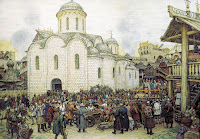There are three major proteges of Tamerlane (Timur) who descend down in History as one of the lists of successful commanders. Their accomplishments in military history barely discuss by any, while they personally effectuated the significant part of the region of his time and their successes were intertwined with the ultimate destiny of Tamerlane's World Conquest. Tokhtamysh Khan, Temur Qutlugh Khan, and Oljei Temur Khan; these three khans were Tamerlane's protege and backed by him to reach their throne.
Hardly anyone can be able to imagine Timur's dominance during his era, he was even undefeated in all of his proxy wars as well, wherever he supported any such Khan (Ruler/Lord) of his choice; later that Khan will emerge as one of the most prominent leaders of his Khanate and influence the greater parts of his region.
Tokhtamysh Khan:
Tokhtamysh (1342-1406 AD), Khan of the Golden Horde briefly united both Blue and White Hordes to form the Golden Horde. With Timur's bucking, he emerged as the most powerful ruler of the Golden Horde and emulates his ancestors in terms of military successes. He defeated Russians and burned Moscow during the siege of Moscow (1382) and also defeated the Polish-Lithuanian forces at the Battle of Poltava. He even reduced both Polish-Lithuanian and Moscovite kingdoms into a vassal and tributary state of the Golden Horde. Tokhtamysh turned against his former master Timur (Tamerlane). It was a fatal mistake that Tokhtamysh did. As a result, he lost his former glory, even his own khanate. Tamerlane invaded his territory twice and dethroned him after the Battle of Terek River (1395) and Tokhtamysh fled west to Lithuania for refuge. Timur then installed his vassal Temur Qutlugh as the Khan of the Blue Horde and Koirichak as the Khan of the White Horde in 1397. Tokhtamysh died a decade later after he was deposed by Timur. He was killed by Edigu (one of Timur's general) in Tyumen, Western Siberia (1406/7).
Temur Qutlugh:
Temur Qutlugh (1370-1399 AD), was the Khan of the Blue Horde. In his shortlived reign (1397-1399), he achieved a decisive victory at the great medieval battle called as Battle of Vorskla River (1399). Very rare people from both Christians and Muslims know this battle, but it was a final major crusade against the Muslims in which Tartar Muslims annihilated the European army and killed more than two-thirds of its soldiers on a battleground (including the 20 princes out of 50, Stephen I, King of Moldavia also died in this battle). The result was a catastrophe for the Crusaders and Tartars pillaged all the lands up to the borders of Moldavia. Qutlugh's retreat tactic was successful during the battle, it encircles the Crusaders army from behind (by Edigu's hordes, a Nogai of Golden Horde) while Vytuatus's army approaches towards the Qutlugh's main force. However, Temur Qutlugh fatally wounded in this battle and later died from his wounds (1399). It was a phenomenal victory for Temur Qutlugh who defeated the less (38,000 Soldiers) but a highly advanced army of Crusaders and sealed the final Muslim victory over the Last Crusade.
Oljei Temur Khan:
Oljei Temur Khan (1379-1412 AD), was the Khan of the Northern Yuan Dynasty based in Mongolia from 1408-1412. Before his coronation in 1408, he was a protege of Tamerlane (Timur) and under came over his lordship until his death in 1405. Temur Khan, also known as Bunyashir Khan converted to Islam when he arrived at the court of Timur in Samarkand, Central Asia. He declared himself a new Khan of the Northern Yuan Khanate with the title of Oljei Temur at Beshbalik (Xinjiang) in 1403. With the help of the Timurid army, he seizes the throne for himself and defeated Orug Temur Khan in 1403. Four years after Timur's death in 1405, Oljei Temur Khan defeated the punitive expedition of the Chinese Ming Empire on September 23, 1409. In response to this defeat, the Ming Empire organized half a million soldiers to defeat Temur Khan Bunyashri. Due to the difference between the Oljei Temur and his grand chancellor Arughtai, the Northern Yuan army unable to organized over a single course of action. Arughtai headed towards the east of Mongolia and Temur Khan headed west. At Onon River, he was suddenly forced to accept the battle against the Ming army in which the Chinese Ming force nearly wipeout the Mongol hordes in 1410. He was barely survived with seven horsemen and his son while all the rest were lost. He was executed by Oirat leader, Mahamud in 1412.
Hardly anyone can be able to imagine Timur's dominance during his era, he was even undefeated in all of his proxy wars as well, wherever he supported any such Khan (Ruler/Lord) of his choice; later that Khan will emerge as one of the most prominent leaders of his Khanate and influence the greater parts of his region.
Tokhtamysh Khan:
Tokhtamysh (1342-1406 AD), Khan of the Golden Horde briefly united both Blue and White Hordes to form the Golden Horde. With Timur's bucking, he emerged as the most powerful ruler of the Golden Horde and emulates his ancestors in terms of military successes. He defeated Russians and burned Moscow during the siege of Moscow (1382) and also defeated the Polish-Lithuanian forces at the Battle of Poltava. He even reduced both Polish-Lithuanian and Moscovite kingdoms into a vassal and tributary state of the Golden Horde. Tokhtamysh turned against his former master Timur (Tamerlane). It was a fatal mistake that Tokhtamysh did. As a result, he lost his former glory, even his own khanate. Tamerlane invaded his territory twice and dethroned him after the Battle of Terek River (1395) and Tokhtamysh fled west to Lithuania for refuge. Timur then installed his vassal Temur Qutlugh as the Khan of the Blue Horde and Koirichak as the Khan of the White Horde in 1397. Tokhtamysh died a decade later after he was deposed by Timur. He was killed by Edigu (one of Timur's general) in Tyumen, Western Siberia (1406/7).
Temur Qutlugh:
Temur Qutlugh (1370-1399 AD), was the Khan of the Blue Horde. In his shortlived reign (1397-1399), he achieved a decisive victory at the great medieval battle called as Battle of Vorskla River (1399). Very rare people from both Christians and Muslims know this battle, but it was a final major crusade against the Muslims in which Tartar Muslims annihilated the European army and killed more than two-thirds of its soldiers on a battleground (including the 20 princes out of 50, Stephen I, King of Moldavia also died in this battle). The result was a catastrophe for the Crusaders and Tartars pillaged all the lands up to the borders of Moldavia. Qutlugh's retreat tactic was successful during the battle, it encircles the Crusaders army from behind (by Edigu's hordes, a Nogai of Golden Horde) while Vytuatus's army approaches towards the Qutlugh's main force. However, Temur Qutlugh fatally wounded in this battle and later died from his wounds (1399). It was a phenomenal victory for Temur Qutlugh who defeated the less (38,000 Soldiers) but a highly advanced army of Crusaders and sealed the final Muslim victory over the Last Crusade.
Oljei Temur Khan:
Oljei Temur Khan (1379-1412 AD), was the Khan of the Northern Yuan Dynasty based in Mongolia from 1408-1412. Before his coronation in 1408, he was a protege of Tamerlane (Timur) and under came over his lordship until his death in 1405. Temur Khan, also known as Bunyashir Khan converted to Islam when he arrived at the court of Timur in Samarkand, Central Asia. He declared himself a new Khan of the Northern Yuan Khanate with the title of Oljei Temur at Beshbalik (Xinjiang) in 1403. With the help of the Timurid army, he seizes the throne for himself and defeated Orug Temur Khan in 1403. Four years after Timur's death in 1405, Oljei Temur Khan defeated the punitive expedition of the Chinese Ming Empire on September 23, 1409. In response to this defeat, the Ming Empire organized half a million soldiers to defeat Temur Khan Bunyashri. Due to the difference between the Oljei Temur and his grand chancellor Arughtai, the Northern Yuan army unable to organized over a single course of action. Arughtai headed towards the east of Mongolia and Temur Khan headed west. At Onon River, he was suddenly forced to accept the battle against the Ming army in which the Chinese Ming force nearly wipeout the Mongol hordes in 1410. He was barely survived with seven horsemen and his son while all the rest were lost. He was executed by Oirat leader, Mahamud in 1412.



No comments:
Post a Comment